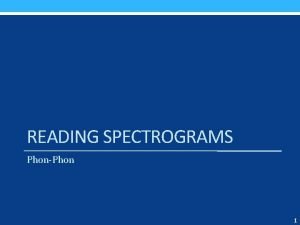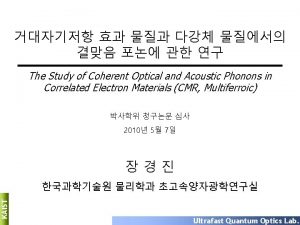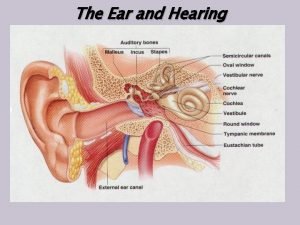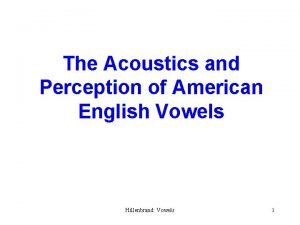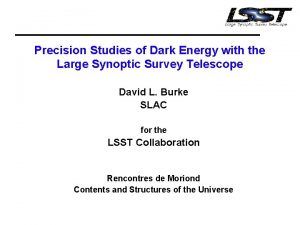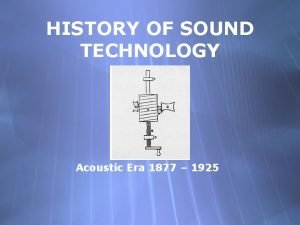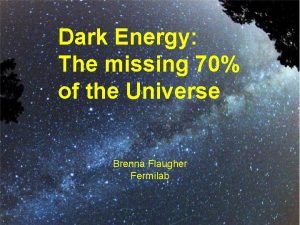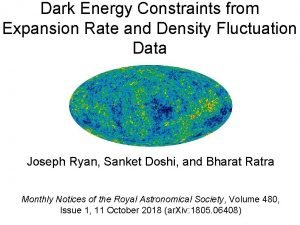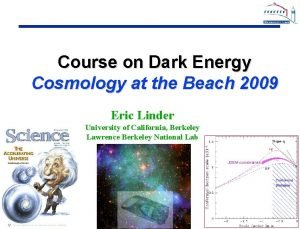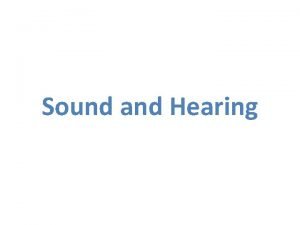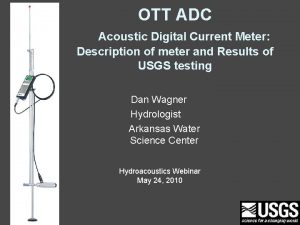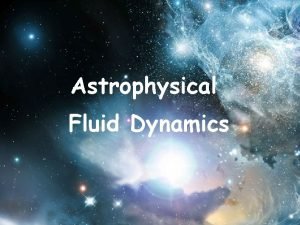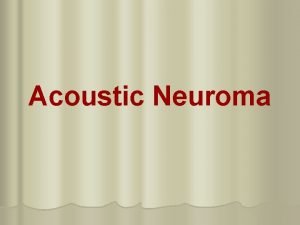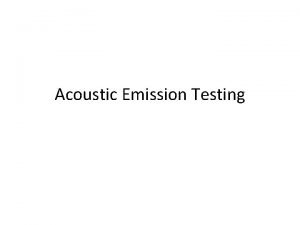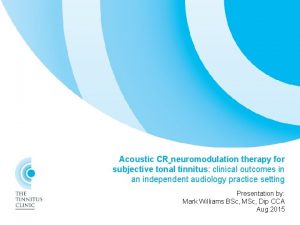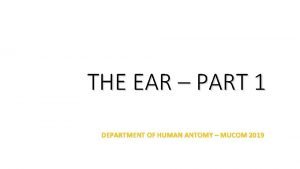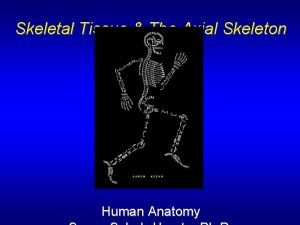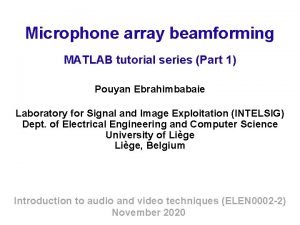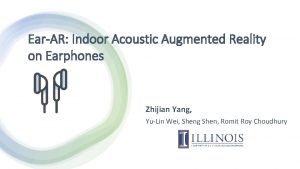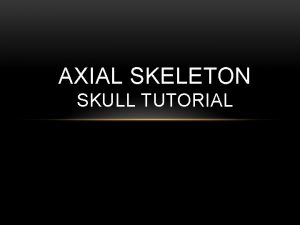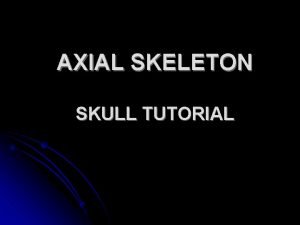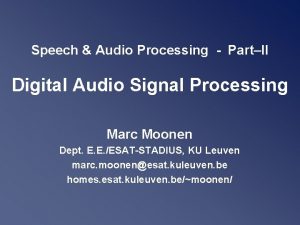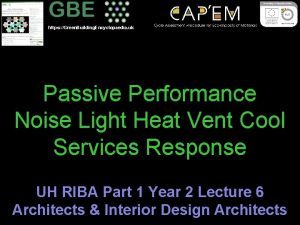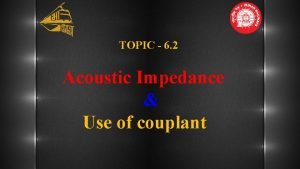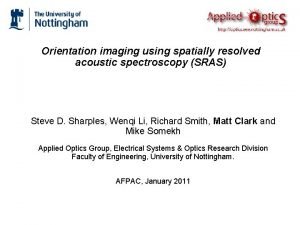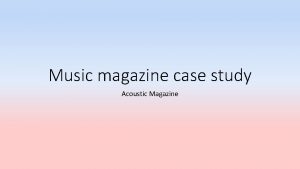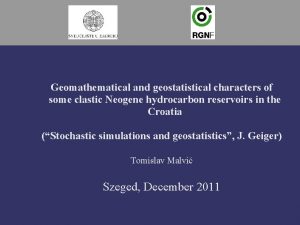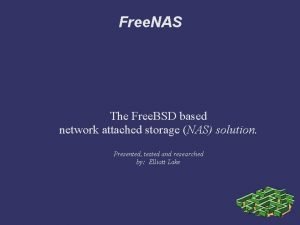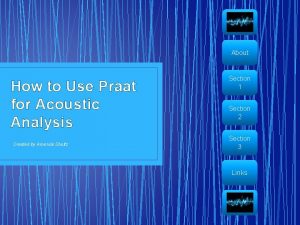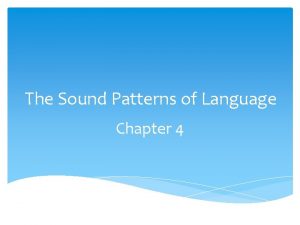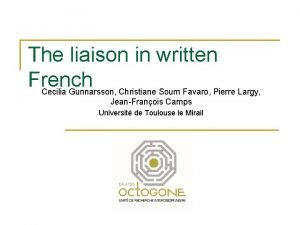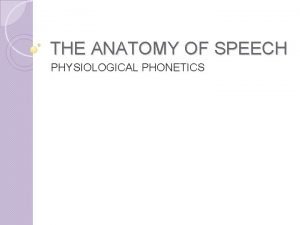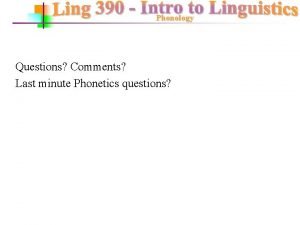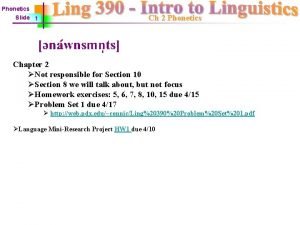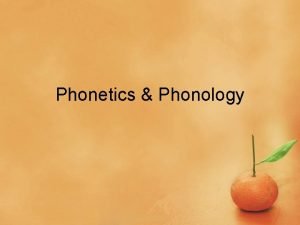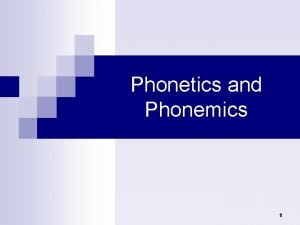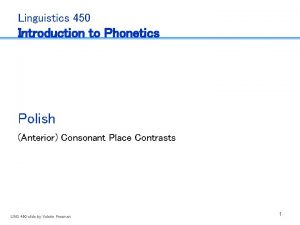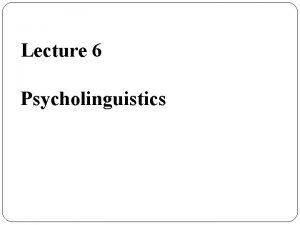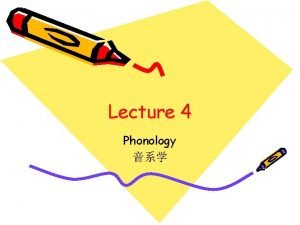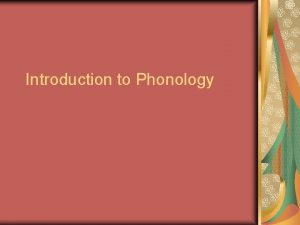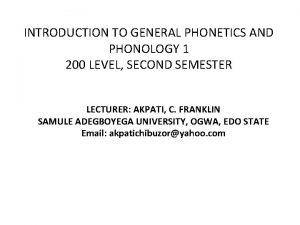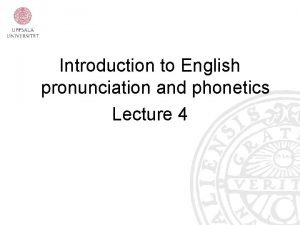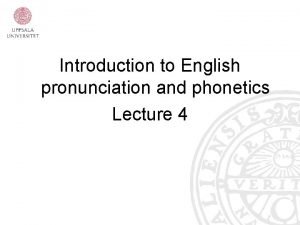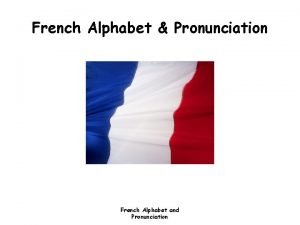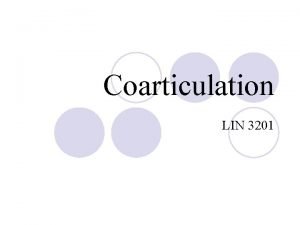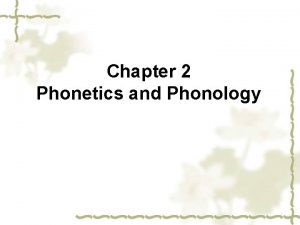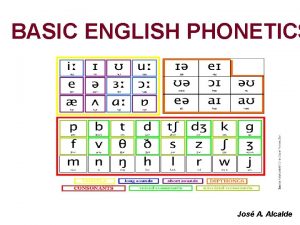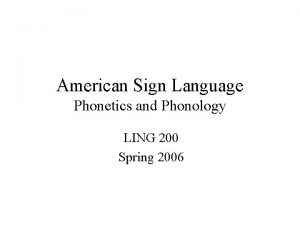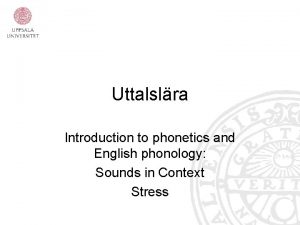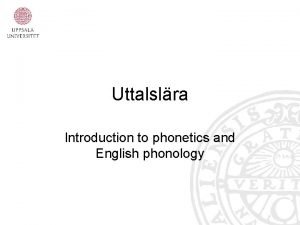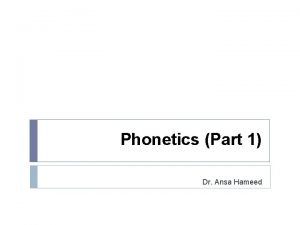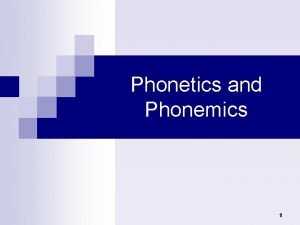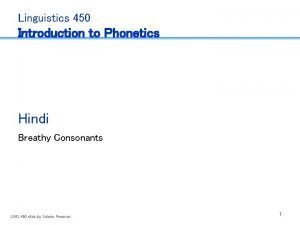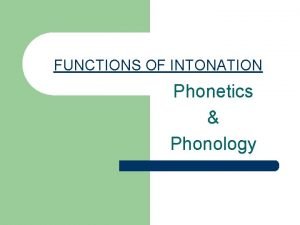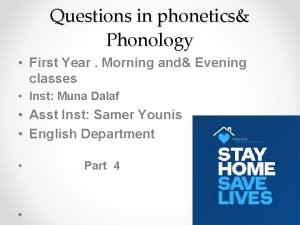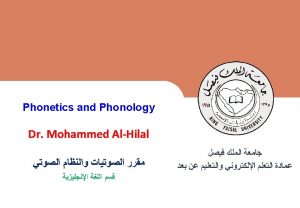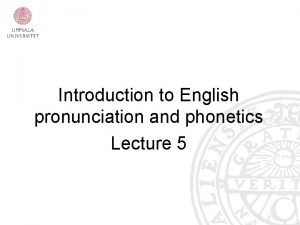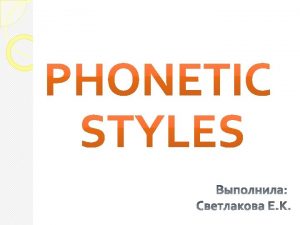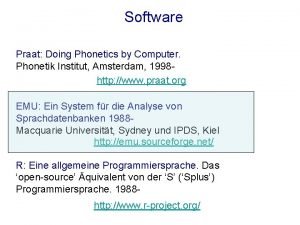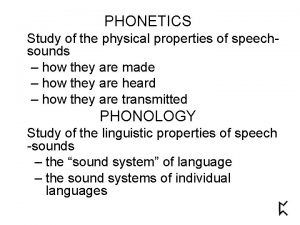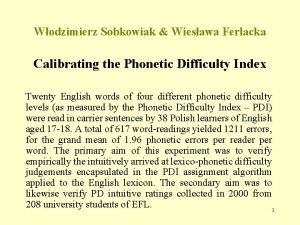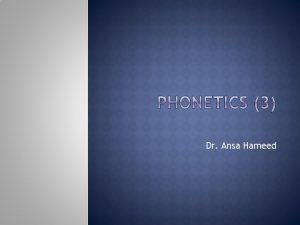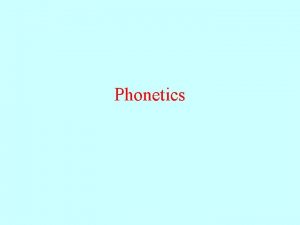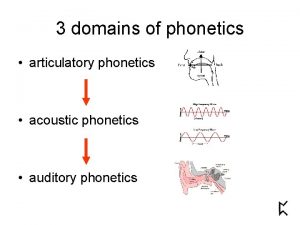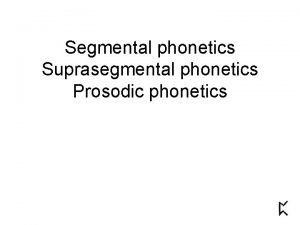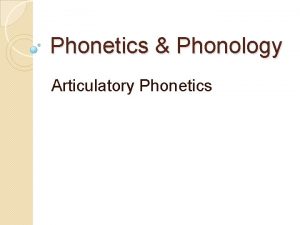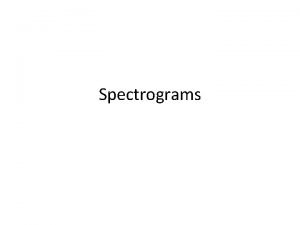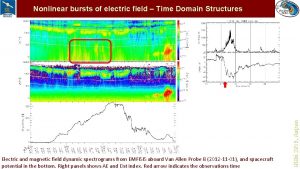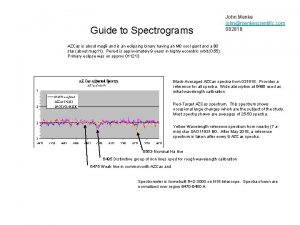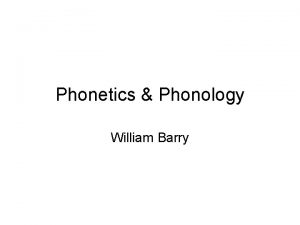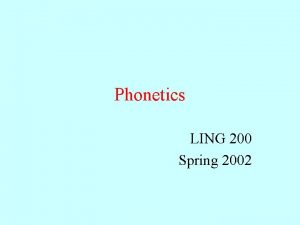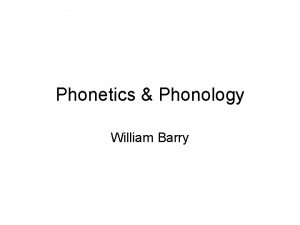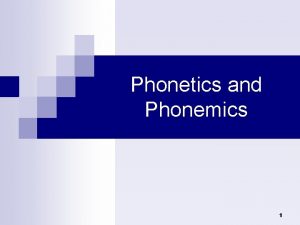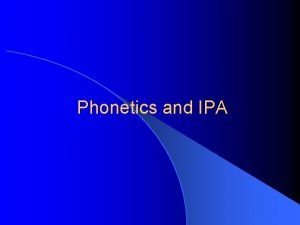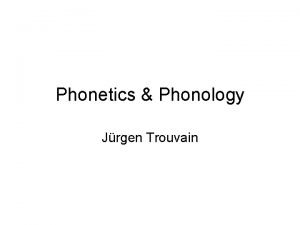READING SPECTROGRAMS PhonPhon 1 Acoustic Phonetics Overview Structure











![Sonorant Consonants • Which consonants? • Approximants • glides [w], [j] • liquids [l], Sonorant Consonants • Which consonants? • Approximants • glides [w], [j] • liquids [l],](https://slidetodoc.com/presentation_image_h/1c0cc75ee6ca4562fe99d7075db7422a/image-12.jpg)

![Sonorant Consonants: Glides [aja] • F 1 low • F 2 high [aia] ◦ Sonorant Consonants: Glides [aja] • F 1 low • F 2 high [aia] ◦](https://slidetodoc.com/presentation_image_h/1c0cc75ee6ca4562fe99d7075db7422a/image-14.jpg)
![Sonorant Consonants: Glides [awa] • F 1 low • F 2 low [aua] ◦ Sonorant Consonants: Glides [awa] • F 1 low • F 2 low [aua] ◦](https://slidetodoc.com/presentation_image_h/1c0cc75ee6ca4562fe99d7075db7422a/image-15.jpg)
![Acoustics of Glides • [j] ~ [i] and [w] ~ [u] • Similar formant Acoustics of Glides • [j] ~ [i] and [w] ~ [u] • Similar formant](https://slidetodoc.com/presentation_image_h/1c0cc75ee6ca4562fe99d7075db7422a/image-16.jpg)













![Spectrogram: “see” can’t really see formants for [s] clear formants for [i] Spectrogram: “see” can’t really see formants for [s] clear formants for [i]](https://slidetodoc.com/presentation_image_h/1c0cc75ee6ca4562fe99d7075db7422a/image-30.jpg)
![Waveform: “see” Aperiodic Sound Source for [s] Waveform: “see” Aperiodic Sound Source for [s]](https://slidetodoc.com/presentation_image_h/1c0cc75ee6ca4562fe99d7075db7422a/image-31.jpg)
![Waveform: “see” Periodic Sound Source for [i] Waveform: “see” Periodic Sound Source for [i]](https://slidetodoc.com/presentation_image_h/1c0cc75ee6ca4562fe99d7075db7422a/image-32.jpg)






![Sibilants • [s] and [ʃ] are known as sibilant fricatives • more acoustic energy Sibilants • [s] and [ʃ] are known as sibilant fricatives • more acoustic energy](https://slidetodoc.com/presentation_image_h/1c0cc75ee6ca4562fe99d7075db7422a/image-39.jpg)
![Fricatives: Place • Wait a minute… what about [h]? • look, three clear, neat Fricatives: Place • Wait a minute… what about [h]? • look, three clear, neat](https://slidetodoc.com/presentation_image_h/1c0cc75ee6ca4562fe99d7075db7422a/image-40.jpg)


![Fricatives: Place • Place revealed in intensity at different frequencies • [f], [θ]: less Fricatives: Place • Place revealed in intensity at different frequencies • [f], [θ]: less](https://slidetodoc.com/presentation_image_h/1c0cc75ee6ca4562fe99d7075db7422a/image-43.jpg)





![[ata] release burst silent gap [ata] release burst silent gap](https://slidetodoc.com/presentation_image_h/1c0cc75ee6ca4562fe99d7075db7422a/image-49.jpg)
![[ada] release burst silent gap [ada] release burst silent gap](https://slidetodoc.com/presentation_image_h/1c0cc75ee6ca4562fe99d7075db7422a/image-50.jpg)





![Formant Transitions: Velar pinch Second and third formants approach each other in velars [bag] Formant Transitions: Velar pinch Second and third formants approach each other in velars [bag]](https://slidetodoc.com/presentation_image_h/1c0cc75ee6ca4562fe99d7075db7422a/image-56.jpg)

![Voiced fricatives: Waveform & Spectrogram [-voice] [+voice] aperiodic no voice bar Voiced fricatives: Waveform & Spectrogram [-voice] [+voice] aperiodic no voice bar](https://slidetodoc.com/presentation_image_h/1c0cc75ee6ca4562fe99d7075db7422a/image-58.jpg)










![[ɑʤɑ] frication silent gap [ɑʤɑ] frication silent gap](https://slidetodoc.com/presentation_image_h/1c0cc75ee6ca4562fe99d7075db7422a/image-69.jpg)
![[ɑʤɑ] periodicity! voice bar [ɑʤɑ] periodicity! voice bar](https://slidetodoc.com/presentation_image_h/1c0cc75ee6ca4562fe99d7075db7422a/image-70.jpg)





- Slides: 75

READING SPECTROGRAMS Phon-Phon 1

Acoustic Phonetics: Overview • Structure of sound: simple periodic sounds • Structure of speech sound: • Complex periodic sounds • Aperiodic sounds • Generating speech sounds • Source-Filter theory • Formants • Measuring speech sounds • Wave forms • Spectrograms 2

Recall: Key Properties of Sound Waves property waveform spectrum amplitude time (period) y-axis x-axis y-axis NONE frequency calculate x-axis

Visualizing Properties of Sound Waves property amplitude time (period) waveform spectrum spectrogram y-axis shading x-axis NONE x-axis frequency calculate x-axis y-axis

Spectrogram with Waveform Note: Praat software gives spectrogram with waveform as default Waveform Spectrogram

(lig. d vs e k) ar pli tu ht d Am Frequency Spectrograms Time

Formants for different vowels

Formants for different vowels

Formants for different vowels

Observing the acoustics of consonants • We will start with sonorant consonants. • Why? • Same sound source as vowels.

Observing the acoustics of consonants
![Sonorant Consonants Which consonants Approximants glides w j liquids l Sonorant Consonants • Which consonants? • Approximants • glides [w], [j] • liquids [l],](https://slidetodoc.com/presentation_image_h/1c0cc75ee6ca4562fe99d7075db7422a/image-12.jpg)
Sonorant Consonants • Which consonants? • Approximants • glides [w], [j] • liquids [l], [ɹ] • Nasals • [m], [n], [ŋ] • Articulatory Phonetics • Consonants = voice, place, and manner

Sonorant Consonants • Voice • All voiced • Complex periodic sounds adjusted by vocal tract like vowels • more constricted than vowels • we will see formants! • Place • Reflected in what happens to the formants • Manner • Reflected in what happens to the formants
![Sonorant Consonants Glides aja F 1 low F 2 high aia Sonorant Consonants: Glides [aja] • F 1 low • F 2 high [aia] ◦](https://slidetodoc.com/presentation_image_h/1c0cc75ee6ca4562fe99d7075db7422a/image-14.jpg)
Sonorant Consonants: Glides [aja] • F 1 low • F 2 high [aia] ◦ F 1 low ◦ F 2 high
![Sonorant Consonants Glides awa F 1 low F 2 low aua Sonorant Consonants: Glides [awa] • F 1 low • F 2 low [aua] ◦](https://slidetodoc.com/presentation_image_h/1c0cc75ee6ca4562fe99d7075db7422a/image-15.jpg)
Sonorant Consonants: Glides [awa] • F 1 low • F 2 low [aua] ◦ F 1 low ◦ F 2 low
![Acoustics of Glides j i and w u Similar formant Acoustics of Glides • [j] ~ [i] and [w] ~ [u] • Similar formant](https://slidetodoc.com/presentation_image_h/1c0cc75ee6ca4562fe99d7075db7422a/image-16.jpg)
Acoustics of Glides • [j] ~ [i] and [w] ~ [u] • Similar formant measurements • Glides shorter and quieter • Why does this make sense? • /j/ = palatal approximant • constriction near palate like front vowels • greater constriction than vowels = very high • /w/ = labio-velar approximant • constriction closer to velum like back vowels • lip rounding like /u/ • greater constriction than vowels = very high

Sonorant Consonants: Liquids • Laterals (like /l/) and rhotics (like /ɹ/) • Among the most sonorous consonants • Can be syllabic • e. g. , ladle [leɪdl ] dapper [dæpɹ ] / [dæpɚ] • Why are they grouped together? • Often pattern together phonotactically • e. g. , may form a cluster • [pɹV] or [pl. V] • [Vɹp], [Vlp] • Other languages: • allophonic relationship • e. g. , Korean: rhotic in onset, lateral in coda • in free variation (can use either)

Sonorant Consonants: Liquids • Acoustics: • Resemble vowels with lowered intensity (like glides) • Both /l/ and /ɹ/ have low F 2 (similar to /w/ glide) • F 3 lowered dramatically in /ɹ/ but not /l/ / ɹaɪ/ Source: Idemaru & Holt (2009) /laɪ/

Sonorant Consonants: Approximants

Sonorant Consonants: Nasals • Sealed-off Oral Cavity: The Implications • Anti-resonances • frequencies at which amplitudes of the harmonics are severely reduced • happens when air in the vocal tract becomes divided between oral and nasal cavities • some sound energy trapped in oral cavity and not resonated through nasal passages • Hence we see anti-formants • area of unusually low intensity in the spectrogram (blank space)

Sonorant Consonants: Nasals • Access to nasal cavity: The Implications • Nasal “murmur” or nasal formant • with nasal cavity, the vocal tract becomes longer • longer resonator = lower frequencies • very low formant (nasal murmur) visible on spectrogram (200 -300 Hz for males) • lower for [m] than [n]; lower for [n] than [ŋ] • [m] makes the biggest VT • [ŋ] the smallest

Acoustics of Nasals decreased amplitude abrupt change antiformant F 2 rising out of bilabial low F 1 [ɑ] [m] [ɑ]

Sonorant Consonants: Nasals • Voiced = formants appear • lower intensity • Place = measurement of first anti-formant • lowest for /m/ • highest for /ŋ/ • Manner • low nasal murmur (nasal formant) • anti-formants • low intensity compared to other sonorants

Obstruent Consonants

Voiceless Obstruents • Stops/plosives • /p/, /t/, /k/ • Fricatives • /f/, /θ/, /s/, /ʃ/, /h/ • Affricates • /ʧ/ • All have voiced counterparts (except /h/)

Voiceless Obstruents: Voice • none of the voiceless obstruents are voiced! • sound source is not phonation • no complex periodic sound wave from the vocal folds • no formants! • sound source = air escaping constriction in the upper vocal tract • creates turbulence • generates noise (= aperiodic sound) • Resonance? • still happens • most effective resonators are those in front of place of constriction • resonator is still the vocal tract, but the parts that resonate are those in front of construction • most relevant for fricatives

(Voiceless) Obstruents: Manner & Place • Manner • Fricatives = continuous turbulent airflow • Stops = complete cessation of airflow + turbulent release • Affricates = stop closure is released into fricative airflow • Different acoustic correlates for each of these • Place • Cues for place will vary with manner

Fricatives: Articulation • Articulators brought close together but without complete occlusion • Require precision • Must have narrow enough constriction to generate frication (turbulent air) • But not so great a constriction that air is fully stopped • English: / f, v, θ, ð, s, z, ʃ, ʒ, h /

Acoustics of Fricatives • Sound source • Frication noise generated by turbulence at point of constriction • at teeth for /θ/, alveolar ridge for /s/, etc. • Resonator • Portion of vocal tract in front of constriction
![Spectrogram see cant really see formants for s clear formants for i Spectrogram: “see” can’t really see formants for [s] clear formants for [i]](https://slidetodoc.com/presentation_image_h/1c0cc75ee6ca4562fe99d7075db7422a/image-30.jpg)
Spectrogram: “see” can’t really see formants for [s] clear formants for [i]
![Waveform see Aperiodic Sound Source for s Waveform: “see” Aperiodic Sound Source for [s]](https://slidetodoc.com/presentation_image_h/1c0cc75ee6ca4562fe99d7075db7422a/image-31.jpg)
Waveform: “see” Aperiodic Sound Source for [s]
![Waveform see Periodic Sound Source for i Waveform: “see” Periodic Sound Source for [i]](https://slidetodoc.com/presentation_image_h/1c0cc75ee6ca4562fe99d7075db7422a/image-32.jpg)
Waveform: “see” Periodic Sound Source for [i]

Fricatives: Sound Source • Two types of turbulence • Channel turbulence • noise produced when airflow escapes from a narrow channel and hits inert outside air • Obstacle turbulence • noise produced when airflow hits an obstacle • louder than channel turbulence

Channel vs. Obstacle Turbulence /f/ and /θ/ • not a lot of obstacles to bounce off of • rely more on channel turbulence • quieter /f /θ / /

Channel vs. Obstacle Turbulence /s/ and /ʃ/ • tongue grooves in order to aim airflow directly at teeth • teeth = obstacle turbulence • louder /s /ʃ / /

Fricatives: Resonance • Resonance of fricatives depends on the length of the tube (“filter”) in front of the constriction (“source”) • Backer constriction lower resonant frequencies • Fronter constriction higher resonant frequencies

Fricatives: Length of cavity in front of constriction

Fricatives: • Resonance of fricatives depends on the length of the tube (“filter”) in front of the constriction (“source”) • Backer constriction lower resonant frequencies • Fronter constriction higher resonant frequencies • helps us differentiate /s/ vs. /ʃ/ • doesn’t work so well for /f/ vs. /θ/ • identical place of articulation (upper teeth) • different active articulator (lips vs. tongue) • not a lot of noise to begin with (flat spectrum) • can try to look at following vowel for cues to place (formant transitions more labial in /f/, more coronal /θ/) • but we haven’t learned this yet • and it’s still hard
![Sibilants s and ʃ are known as sibilant fricatives more acoustic energy Sibilants • [s] and [ʃ] are known as sibilant fricatives • more acoustic energy](https://slidetodoc.com/presentation_image_h/1c0cc75ee6ca4562fe99d7075db7422a/image-39.jpg)
Sibilants • [s] and [ʃ] are known as sibilant fricatives • more acoustic energy at higher frequencies than other fricatives because they: • are obstacle fricatives • air aimed at teeth louder • have small, short resonating cavity higher frequency resonance Sibilants Not sibilants
![Fricatives Place Wait a minute what about h look three clear neat Fricatives: Place • Wait a minute… what about [h]? • look, three clear, neat](https://slidetodoc.com/presentation_image_h/1c0cc75ee6ca4562fe99d7075db7422a/image-40.jpg)
Fricatives: Place • Wait a minute… what about [h]? • look, three clear, neat peaks… like a vowel!

/h/ • Basically a voiceless vowel • takes on (very weak) formants of whatever vowel follows it • source at glottis, like vowel, but aperiodic • vocal tract already in place for next vowel

Voiceless Fricatives: Manner • Turbulent release of air = broad range of frequencies and no real formants [s] [f] [ʃ] [θ] [h] "Some find shiny things here. ” http: //home. cc. umanitoba. ca/~robh/archives/arc 0703. html
![Fricatives Place Place revealed in intensity at different frequencies f θ less Fricatives: Place • Place revealed in intensity at different frequencies • [f], [θ]: less](https://slidetodoc.com/presentation_image_h/1c0cc75ee6ca4562fe99d7075db7422a/image-43.jpg)
Fricatives: Place • Place revealed in intensity at different frequencies • [f], [θ]: less intense, even distribution of intensity, harder to tell apart • [s], [ʃ]: high intensity, [ʃ] has lower intense frequencies • [h]: can sometimes see weak formants for following vowel [s] [f] [ʃ] [θ] [h] "Some find shiny things here. ” http: //home. cc. umanitoba. ca/~robh/archives/arc 0703. html

Voiceless Fricatives: Summary • Turbulence provides the source of fricative noise • obstacle turbulence ([s], [ʃ]) louder than channel turbulence ([f], [θ]) • Filter of fricative turbulence noise is based on the place of articulation • [f], [θ]: essentially no filter (flat spectrum) • [s], [ʃ]: short filter, emphasizing higher frequencies • [h]: longer, more vowel-like filter • Sibilants are loud fricatives with concentrations of intensity at high frequencies • [s], [ʃ]

(Voiceless) Obstruents: Manner & Place • Manner • Fricatives = continuous turbulent airflow • Stops = complete cessation of airflow + turbulent release • Affricates = stop closure is released into fricative airflow • Different acoustic correlates for each of these • Place • Cues for place will vary with manner

Stops: Articulation • Three stages of articulation • Closing phase • Maintain closure • Release of closure

Stops: Articulation & Acoustics • Maintain closure • acoustically, nothing is happening • completely blank space on spectrogram • Release of closure • “release burst” of air • vertical “spike” of energy on waveform • more prominent for voiceless than voiced stops

Voiceless Stops: Manner • First, silence • blank space on spectrogram • (maybe some residual voicing, but not much) • Then, release burst • Air rushes out of the mouth at high speed, producing a pressure impulse that lasts ~ 2 -3 ms • “transient” • produced at place of articulation • i. e. , the source during the release is the air that escapes from that place of articulation
![ata release burst silent gap [ata] release burst silent gap](https://slidetodoc.com/presentation_image_h/1c0cc75ee6ca4562fe99d7075db7422a/image-49.jpg)
[ata] release burst silent gap
![ada release burst silent gap [ada] release burst silent gap](https://slidetodoc.com/presentation_image_h/1c0cc75ee6ca4562fe99d7075db7422a/image-50.jpg)
[ada] release burst silent gap

Stops: Place • Formant Transitions • change in formants in the vowels on either side of a consonant • reflects place of articulation • F 1 • always low next to stops • (drops into stops, rises out of stops) • high tongue position = low F 1 • stop = highest tongue position there is (full closure) • F 2 • place of constriction shapes transitions for stops • direction of formant movement depends on place of consonant and the vowel

Oral Cavity Size and F 2 small oral cavity high F 2 large oral cavity low F 2

Formant Transitions: Labials F 2 F 1 Labials • largest oral cavity possible • larger than any vowel • lower F 2 than any vowel • F 2 goes from low to high into a vowel • F 2 goes from high to low into a labial

Formant Transitions: Coronals • larger oral cavity than frontish vowels • F 2 lower than vowel • smaller oral cavity than backish vowels • F 2 higher than vowel

Formant Transitions: Dorsals • smallest oral cavity possible • smaller than any vowel • higher F 2 than any vowel • F 2 goes from high to low into a vowel • F 2 goes from low to high into a velar
![Formant Transitions Velar pinch Second and third formants approach each other in velars bag Formant Transitions: Velar pinch Second and third formants approach each other in velars [bag]](https://slidetodoc.com/presentation_image_h/1c0cc75ee6ca4562fe99d7075db7422a/image-56.jpg)
Formant Transitions: Velar pinch Second and third formants approach each other in velars [bag] [bak]

Obstruents: Voiced vs. Voiceless • Voiced obstruents • Sound source = phonation and VT-generated noise • Fricatives • voicing bar (low frequency) • voiced versions also usually shorter and quieter • Stops/plosives • voicing bar (low frequency) • VOT (Voice Onset Time) in English
![Voiced fricatives Waveform Spectrogram voice voice aperiodic no voice bar Voiced fricatives: Waveform & Spectrogram [-voice] [+voice] aperiodic no voice bar](https://slidetodoc.com/presentation_image_h/1c0cc75ee6ca4562fe99d7075db7422a/image-58.jpg)
Voiced fricatives: Waveform & Spectrogram [-voice] [+voice] aperiodic no voice bar

Voiced Fricatives • How can we tell the difference between voiced and voiceless fricatives on a spectrogram? • voicing bar! • How about a waveform? • voiced fricative shows aperiodic noise superimposed on periodic signal of vocal fold vibration Source: http: //home. cc. umanitoba. ca/~krussll/phonetics/acoustic/sp Source: http: //clas. mq. edu. au/acoustics/waveforms/speech_waveforms. ht

Stops: English Voicing Contrast • Phonologically: • “voiceless” vs. “voiced” • Phonetically: • In initial position (usually) • /p/: Voiceless aspirated [pʰ] • /b/: Voiceless unaspirated [p] • /sp/: Voiceless unaspirated [p] (same as initial /b/) • Intervocalic • /p/: Voiceless aspirated [pʰ] • /b/: Voiced [b] (sometimes)

Stops: Voice Onset Time (VOT) • Time between the release of a stop closure and the beginning of voicing (usually for a vowel) • On waveform/spectrogram • milliseconds as the duration between the vertical spike marking transient burst and the first vocal pulse that can be observed at baseline • Positive: voicing starts after stop release • Negative: voicing starts before stop release

Stops: Voice Onset Time (VOT) • Time between the release of a stop closure and the beginning of voicing (usually for a vowel) • For aspirated stops: 1. Stop closure is made 2. Airflow builds up pressure behind closure 3. Closure is released (with a “burst”) 4. Air flows unimpeded through glottis (“aspiration”) • different source than release burst! • burst = area of constriction • aspiration = glottis 5. Vocal folds adduct & voicing begins for vowel

Stops: Voice Onset Time (VOT) • time between the release of a stop closure and the beginning of voicing (usually for a vowel) • For unaspirated stops: 1. Stop closure is made 2. Airflow builds up pressure behind closure 3. Closure is released (with a “burst”) 4. Air flows unimpeded through glottis (“aspiration”) 5. Vocal folds adduct & voicing begins for vowel AT THE SAME TIME AS (3)

Stops: Voice Onset Time (VOT) Note: A true “voiced” plosive would adduct the vocal folds earlier (during hold)

Stops: Acoustic cues for “voicing” • Voiceless aspirated stops: • VOT 40 - 100 milliseconds • Voiceless unaspirated stops: • VOT 0 - 20 milliseconds • (these are our “voiced” stops in English) • Voiced stops: • VOT < 0 milliseconds • voicing already occurs during closure • uncommon in American English

“peach” 57 ms VOT

“beach” no voice bar 7 ms VOT

“speech” 7 ms VOT
![ɑʤɑ frication silent gap [ɑʤɑ] frication silent gap](https://slidetodoc.com/presentation_image_h/1c0cc75ee6ca4562fe99d7075db7422a/image-69.jpg)
[ɑʤɑ] frication silent gap
![ɑʤɑ periodicity voice bar [ɑʤɑ] periodicity! voice bar](https://slidetodoc.com/presentation_image_h/1c0cc75ee6ca4562fe99d7075db7422a/image-70.jpg)
[ɑʤɑ] periodicity! voice bar

A Grand Summary: Manner

A Grand Summary: Place

A Grand Summary: Voice

Practice: Segmenting Waveforms

Practice: Segmenting Spectrograms
 Reading a spectrogram
Reading a spectrogram While reading activities
While reading activities Optical vs acoustic phonons
Optical vs acoustic phonons What is the function of the external acoustic meatus
What is the function of the external acoustic meatus Acoustic characteristics of american english vowels
Acoustic characteristics of american english vowels Baryon acoustic oscillations
Baryon acoustic oscillations Acoustic era
Acoustic era The universe faster than should be
The universe faster than should be Baryon acoustic oscillations
Baryon acoustic oscillations Baryon acoustic oscillations
Baryon acoustic oscillations Acoustic technician
Acoustic technician Acoustic stimulus is
Acoustic stimulus is Ott current meter
Ott current meter Lecture hall acoustics
Lecture hall acoustics Baryonic acoustic oscillations
Baryonic acoustic oscillations Rollover phenomenon in acoustic neuroma
Rollover phenomenon in acoustic neuroma Acoustic emissions testing
Acoustic emissions testing Acoustic cr
Acoustic cr Ear anatomy
Ear anatomy Mesenchyme cells
Mesenchyme cells Microphone array matlab
Microphone array matlab Acoustic meatus
Acoustic meatus Ear-ar: indoor acoustic augmented reality on earphones
Ear-ar: indoor acoustic augmented reality on earphones B&k acoustic camera
B&k acoustic camera External acoustic meatus
External acoustic meatus Perpendicular plate and vomer
Perpendicular plate and vomer Digital audio and speech
Digital audio and speech Mail @ greenbuildingencyclopaedia.uk
Mail @ greenbuildingencyclopaedia.uk Acoustic impedance of steel
Acoustic impedance of steel Spatially resolved acoustic spectroscopy
Spatially resolved acoustic spectroscopy Acoustic magazine uk
Acoustic magazine uk Acoustic impedance
Acoustic impedance Bsd nas
Bsd nas How to measure vot in praat
How to measure vot in praat Phonetic speech sounds
Phonetic speech sounds Sound patterns examples
Sound patterns examples Cecilia gunnarsson
Cecilia gunnarsson Phonetic anatomy
Phonetic anatomy How many vowel
How many vowel Difference between phonetics and phonology
Difference between phonetics and phonology Regressive assimilation examples
Regressive assimilation examples Allophones examples
Allophones examples Dissimilation phonetics
Dissimilation phonetics Articulators theatre definition
Articulators theatre definition Phonetics ch
Phonetics ch Phonetics and phonology
Phonetics and phonology Introduction to english linguistics exercises answers
Introduction to english linguistics exercises answers Phonetics and phonemics
Phonetics and phonemics Anterior consonant
Anterior consonant Difference between phonetics and phonology
Difference between phonetics and phonology Phonemic transcription
Phonemic transcription Phonology
Phonology Introduction to general phonetics and phonology
Introduction to general phonetics and phonology Word stress
Word stress Example of elision
Example of elision French alphabet sound
French alphabet sound Co-articulation
Co-articulation Phonetics vs phonology
Phonetics vs phonology What are the 8 diphthongs
What are the 8 diphthongs Sign language phonetics
Sign language phonetics Progressive assimilation
Progressive assimilation Phonetics
Phonetics Hameed pronunciation
Hameed pronunciation Phonemics and phonetics
Phonemics and phonetics Hindi consonant chart
Hindi consonant chart Intonation functions
Intonation functions Phonetics chinese
Phonetics chinese Questions about phonetics
Questions about phonetics What is the difference between phonetics and phonology
What is the difference between phonetics and phonology Ga phonetics
Ga phonetics Phonostylistics as a branch of phonetics
Phonostylistics as a branch of phonetics Praat doing phonetics by computer
Praat doing phonetics by computer The study of the physical properties of speech sounds
The study of the physical properties of speech sounds Ucla phonetics
Ucla phonetics Elearning
Elearning Weslande taxi
Weslande taxi
